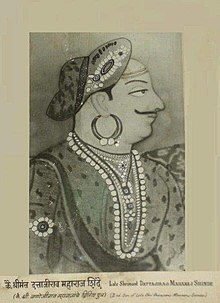| Sardar Dattaji Shinde (Scindia) Scindia | |
|---|---|
 Dattaji Shinde (Scindia) Dattaji Shinde (Scindia) | |
| Born | c. 1723 |
| Died | 10 January 1760(1760-01-10) (aged 36–37) |
| Allegiance | |
| Battles / wars |
|
| Relations | Ranoji Shinde (father) Jayappaji Rao Scindia (brother) Jankoji Rao Scindia (nephew) Jyotiba Rao Scindia (brother) Tukoji Rao Scindia (halfbrother) Mahadji Shinde (halfbrother) |
Dattaji Rao Shinde, also known as Dattaji Rao Scindia, (c. 1723 – 10 January 1760) was the second son of Ranoji Rao Shinde and Maina Bai, alias Nimba Bai. His elder brother was Jayappaji Rao Shinde and his younger brother was Jyotiba.
Early life
Dattajirao was the elder half-brother of Mahadaji Shinde, who later became the confederacy head of Gwalior princely state, famous fabricator of the Great Maratha Resurrection of 1771, and also the regent for his nephew Jankoji Rao Shinde, from 1755 until Jankoji's death in 1761.
Battle with Afghans and death
| This section needs additional citations for verification. Please help improve this article by adding citations to reliable sources in this section. Unsourced material may be challenged and removed. (February 2023) (Learn how and when to remove this message) |
Balaji Baji Rao, also called Nanasaheb Peshwa, gave Dattaji Rao command of the subjugated Punjab and Multan provinces, with an army of 18,000 cavalry to stop the Afghan invasion led by Ahmed Shah Durrani, also called Ahmad Shah Abdali. The Marathas had captured the forts of Attock and Peshawar in 1757–1758, and wanted to expand their rule up to Kabul, Kandahar and the Afghanistan-Iran border. After many centuries since 1020, when Mahmud of Ghazni, head of the Ghazanavids, had defeated the Hindu ruler Trilochanpala and Hindushahi of ancient Gandhar and Punjab regions, Hindu rule had returned to integrated Punjab province and the entire Indus River region.
After the fiercest wars in Punjab and Multan area, the victorious Raghunath Rao, returned to Delhi and then to Pune, in hurryly manner, without appointing the range commanders, for subjugated Punjab and Multan region. He wasn't much interested to settle down and rule in this region permanently, away from the luxuries of Pune, their own seat and throne area. Eventually, this proved as a historical mistake of the Grand Maratha Confederation Army's top leadership.
In March 1759, Dattaji Rao Shinde, reached Machhiwara with a massive army, of approximate 40,000 cavalry men, but just like Raghunath Rao, Dattajirao also did not want to settle down in Punjab on permanent basis, as he was fully determined to root out the main enemy of then Maratha empire, i.e Najib ad-Dawlah Rohilla. He wrote an intimation letter to the Nanasaheb Peshwa in Pune, and deployed Sabajirao Shinde to take over the garrison of Punjab with the assistance of Bapu Rao and Dadu Rao Shinde. Dattajirao himself went to fight with Najib Khan Rohilla, in the Doab, popularly known as the Antarvedi area. But due to absence of Sabajirao Shinde in Rohtas Fort, Afghans under General Jahan Khan attacked Attock and Rohtas fort and won those back again from the Marathas. Sabajirao Shinde and local Sikhs rallied and defeated Afghans in Battle of Lahore, (1759). Afghan General Jahan Khan lost his only son in this battle and once again, Afghans retreated to Afghanistan. This victory of Marathas at Lahore, made Ahmad Shah Abdali more aggressive and hugely upset. Then Afghans and Rohilla allied and sent Jahan Khan with the massive army of 60,000 cavalry. Jahan Khan won Attock and Peshawar by defeating Maratha garrison decisively. General Jahan Khan then defeated Triyambak Rao's platoon size army of 6,000 men and Abdali moved towards south Punjab immediately. They captured Lahore, capital of Punjab.
Ahmad Shah Abdali attacked Dattaji's party of 2,500 men, outside Delhi, before the main battle. After this skirmish, Abdali regrouped with Najib ad-Dawlah, and Dattajirao retreated in to the Delhi fort, for rearranging the Maratha garrison for the main battle. Ahmad Shah Abdali then allied with the 60,000 army of Najib-ud-Daula, and together with approximately 1,20,000 men, they attacked on Dattajirao at final time. On 10 January 1760, in the Battle of Buradi Ghat, also known as the Burrari, or Barari Ghat, on the banks of river Yamuna, near Delhi, Dattaji's outnumbered army was totally defeated and then he was beheaded, by the Mian Qutub Shah and Najib ad-Dawlah Rohilla.
Today also, Dattaji is remembered in the popular Maratha history for his last words when Qutub Shah & Najib said, "Kyu Patil, aur ladenge" and Dattaji Shinde replied, "kyu nahi.. bachenge to aur bhi ladenge", which he said to the Mian Qutub Shah & Najib ad-Dawlah while dying.
In popular culture
- In the 1994 Hindi TV series The Great Maratha, Dattaji's character was portrayed by Mangal Dhillon.
- In the 2019 Bollywood film Panipat, Dattaji Rao Scindia was portrayed by Milind Gunaji.
See also
References
- Abhas Verma, "Third Battle of Panipat" , Bhartiya Kala Prakashan, ISBN 9788180903397
- Mehta, Jaswant Lal (2005). Advanced Study in the History of Modern India 1707-1813. New Dawn Press Inc. p. 258. ISBN 9781932705546.
- Jaywant Joglekar (2006). Decisive Battles India Lost (326 B. C. to 1803 A. D.). pp. 85–86. ISBN 9781847283023.
- N. G. Rathod (1994). The Great Maratha Mahadaji Scindia. p. 3. ISBN 9788185431529.
- Jaswant Lal Mehta (2005). Advanced Study in the History of Modern India 1707-1813. p. 262. ISBN 9781932705546.
- this number is 120,000